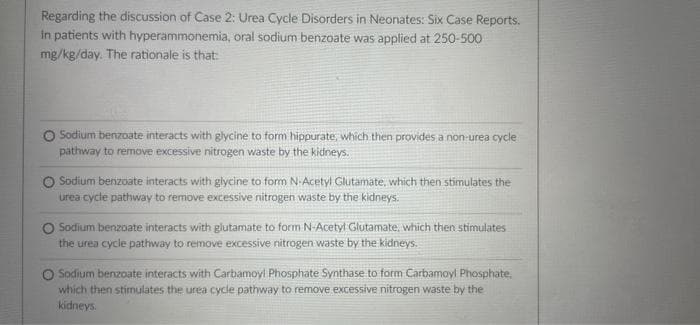Regarding the discussion of Case 2: Urea Cycle Disorders in Neonates: Six Case Reports. In patients with hyperammonemia, oral sodium benzoate was applied at 250-500 mg/kg/day. The rationale is that O Sodium benzoate interacts with glycine to form hippurate, which then provides a non-urea cycle pathway to remove excessive nitrogen waste by the kidneys. O Sodium benzoate interacts with glycine to form N-Acetyl Glutamate, which then stimulates the urea cycle pathway to remove excessive nitrogen waste by the kidneys. O Sodium benzoate interacts with glutamate to form N-Acetyl Glutamate, which then stimulates the urea cycle pathway to remove excessive nitrogen waste by the kidneys. O Sodium benzoate interacts with Carbamoyl Phosphate Synthase to form Carbamoyl Phosphate, which then stimulates the urea cycle pathway to remove excessive nitrogen waste by the kidneys
Regarding the discussion of Case 2: Urea Cycle Disorders in Neonates: Six Case Reports. In patients with hyperammonemia, oral sodium benzoate was applied at 250-500 mg/kg/day. The rationale is that O Sodium benzoate interacts with glycine to form hippurate, which then provides a non-urea cycle pathway to remove excessive nitrogen waste by the kidneys. O Sodium benzoate interacts with glycine to form N-Acetyl Glutamate, which then stimulates the urea cycle pathway to remove excessive nitrogen waste by the kidneys. O Sodium benzoate interacts with glutamate to form N-Acetyl Glutamate, which then stimulates the urea cycle pathway to remove excessive nitrogen waste by the kidneys. O Sodium benzoate interacts with Carbamoyl Phosphate Synthase to form Carbamoyl Phosphate, which then stimulates the urea cycle pathway to remove excessive nitrogen waste by the kidneys
Chapter23: Protein-, Mineral-, And Fluid-modified Diets For Kidney Diseases
Section: Chapter Questions
Problem 1CA
Related questions
Question

Transcribed Image Text:Regarding the discussion of Case 2: Urea Cycle Disorders in Neonates: Six Case Reports.
in patients with hyperammonemia, oral sodium benzoate was applied at 250-500
mg/kg/day. The rationale is that:
Sodium benzoate interacts with glycine to form hippurate, which then provides a non-urea cycle
pathway to remove excessive nitrogen waste by the kidneys.
O Sodium benzoate interacts with glycine to form N-Acetyl Glutamate, which then stimulates the
urea cycle pathway to remove excessive nitrogen waste by the kidneys.
Sodium benzoate interacts with glutamate to form N-Acetyl Glutamate, which then stimulates
the urea cycle pathway to remove excessive nitrogen waste by the kidneys.
Sodium benzoate interacts with Carbamoyl Phosphate Synthase to form Carbamoyl Phosphate,
which then stimulates the urea cycle pathway to remove excessive nitrogen waste by the
kidneys.
Expert Solution
This question has been solved!
Explore an expertly crafted, step-by-step solution for a thorough understanding of key concepts.
Step by step
Solved in 2 steps

Recommended textbooks for you







Essentials of Pharmacology for Health Professions
Nursing
ISBN:
9781305441620
Author:
WOODROW
Publisher:
Cengage